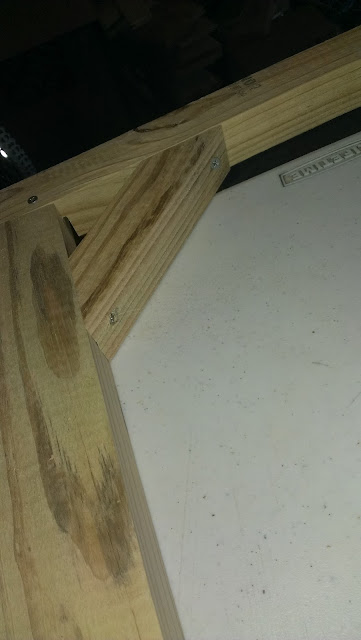When I was choosing my material for the bench tops, I found Poplar, Aspen and Cedar to all be acceptable in a sauna hot room. I ended up buying Aspen simply because it seemed cheaper and was in stock at the store as opposed to Cedar and Poplar. The boards were grade "A" without knots and polished smooth which seemed perfect at the time.
Afterthought:
The smooth wood is like glass and seems to really heat up. In comparison, when putting up the cedar on the walls, we had a choice of using the smooth side of the boards or the rough side and I chose the rough side. In my mind, the rough side acts like fins on an engine and cools the wood. This polished Aspen I now have on the bench tops is smooth with no fins and gets pretty darn hot. I may try roughening it up, but you think about this afterthought when you select your bench-top wood.
Mar 23, 2016
Mar 22, 2016
Building custom sauna benches and bench supports from scratch.
Up next we needed to build the sauna benches for the hot room. The bench layout in the room was constrained by the restrictions on clearances to combustibles imposed by the stove. The layout we had decided on was L-shape benches having a short bench run parallel to the wall opposite the stove, and a long bench running on the perpendicular wall to the right of the stove.
Next, we had to decide on the widths and heights of our benches. There are suggestions online, but, we decided it would be a subjective processes for us. For the height of our benches, we made our decision by estimating our average heights and decided on the bench being such that we could be sitting as high as possible without even the tallest guys hitting their head on the ceiling. I think the final height of top of the bench support ended up being 38 inches from the floor. Next, we needed to decide on the width of the bench. Same thing there—we measured an average from the back to the knees of the guys that’d use the sauna and came up with an 18” bench frame followed by about a 1” face piece. So now we had a rough idea of what we were doing.
Now, I needed to research which wood to use for the tops of our benches. I knew the bench frame would be done with Pressure Treated wood to save money. However, for the top bench finish, I had some choices. Obviously, cedar is a valid choice—but expensive and not sold everywhere. One note here, you need to use “clear”, “grade A”, “finishing” wood so there’s no splinters. Some popular woods are Poplar, Aspen, Birch. You can’t use pine or pine variants, they seep sap (seep sap, seep sap….). My decision came down to price, and the ease of purchase/availability. I chose Aspen. It’s a bright white wood without any significant smell. Not my first choice, but I decided I’ll redo it once I play and win the lottery.
With the Aspen bought ($200+), it was time to frame. We decided that the short bench would be the easiest since it didn’t require supports below it—only on the back and the 2 side walls. We had previously marked off the studs on the walls of the hot room, over cedar, where the benches would go. We now cut our Pressure Treated pieces to the lengths we wanted and installed them on the long wall and the short wall of where the benches will go. These will support the back of each bench. We secured them with 3 inch screws, two per stud, pre-drilling and screwing in to the studs at each marked location. We also cut a 2x4, the width of the bench and secured it to the opposite wall giving us the third of our three supports. Once we build the bench, it will simply rest on top of the three, 1.5 inch wide supports of the walls.
To build the bench we worked on a table outside of the building giving us plenty of space. We cut two Pressure Treated 2x4s the width of our hot room (minus .25 inch to be able to rotate the bench) for the long side of the bench, and 2 more that would be 18 inches, minus 1.5 + 1.5 to for the short side of the frame (the width of the bench). We secured all 4 sides in a rectangle shape by pre-drilling and using 3 inch screws. It’s OK to have the screw tops exposed, no need to sink them yet. They will be covered by Aspen, so no one will ever get burned on them.
 |
| Framing a sauna bench from pressure treated 2x4s. |
With a basic frame complete, we took it in to the hot room to test fit. We placed it over our supports at the walls. It fit and seemed to be good. REMEMBER— build the frame about a quarter inch shorter than the distance between the two opposite walls so that you can maneuver the bench without getting it stuck on the wall. You will need to be able to remove benches for cleaning and such.
Next, we took the bench frame back out and added more dividers/supports between the long sides of the bench frame to make the bench rigid. We did this about every foot and a half. Now came the tricky part. You can’t have any screws exposed or they’ll get hot and burn people. So the Aspen needs to be attached to the bench from underneath the bench frame. To do that, we split a few 2x4s in twos and attached them to our dividers flush with where the top would be in an L-corner fashion.
 |
| Sauna bench framing with blocking and L-corners to attach the top boards from underneath. |
These 2x2s were attached with 2 screws on both opposite sides. We then measured and cut our Aspen and ran screws from underneath the bench frame, through the 2x2 strips we attached half way in to the Aspen making sure they didn’t come all the way through. As always, we pre-drilled the holes before putting in the screws. In order to keep the space between the Aspen boards consistent, we used scrap DuRock pieces to maintain a half inch gap. The last Aspen board was cut to the remaining width of the bench and nailed to the frame with brads at a slightly higher air pressure then needed to make sure they sunk in well. Remember, this board is at the back of the bench. With the final board in place, we had our first bench. We put it back on the supports in the hot room and tried sitting on it. It held all 3 of us big guys very well. The only piece that was left is to attach the Aspen piece to the façade of the bench.
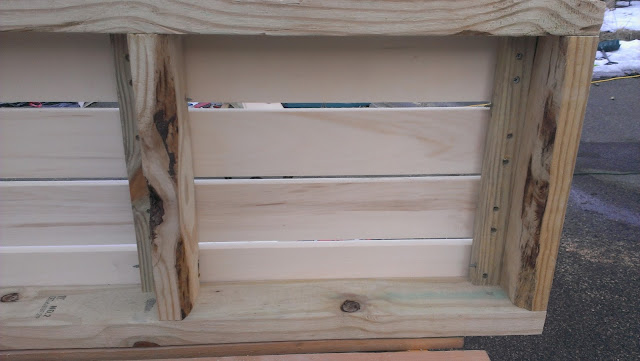 |
| Bench top wood secured to the bench frame from underneath. |
 |
| Side view of the assembled sauna bench. |
The first bench we put together, we decided that a 18 inch width would work. After using it for a week, we decided we wanted to build the next bench a bit wider—perhaps 20 inches. Also, the next bench would be a little more tricky because it required building support underneath it since it didn’t have parallel walls to rest on. There were several hurdles with this support. One, the floor is concave for draining in the place where the bench would be. Two, the bench needed to be tied in to the wall studs to be sturdy, not just the cedar.
To begin, we decided to use a treated 2x4, the length of the bench, that we would attach to the floor. So we cut one and laid it down. Then, we measured up to the height of our bench, 38 inches, and cut two pieces that would go perpendicular to the floor piece. We only did this for the two opposite sides of the floor piece. This is because we wanted the part that flexes in the middle to be fully attached to the floor so we get the accurate measurements before we made any cuts. With the 2 pieces cut, we pre-drilled and screwed them from the bottom of the floor plate on to the floor plate. We then laid the floor plate equal distance from the wall and attached it to the floor, using two 4 inch screws in one foot separations.
Next, we cut another piece of treated 2x4 that would be the top plate for our support structure. We put a level going from our top plate to the 2x4 support which we previously attached to the wall. The benches would sit on top of both supports. The level showed we were still alright. We then pre-drilled holes and attached the top plate to the 2 pieces on both sides of the standalone support.
From here on, things were a bit easier. First, going off the locations of the screws that attached the wall bench support to the wall, we could tell where the studs were (along with our previous markings). We would need to attach blocking right underneath that support so that we could secure our standalone bench support to the studs. We simply used about 12 inch long pieces of treated 2x4, going the long way down and screwed one to each of the studs.
Now that we had blocking to securely tie the bench support to, we needed to finish building the studs of the standalone bench support structure. The only trick to that was that the edge of each stud needed to line up flush with the edge of each of the blocking we installed on the wall. Once we got each stud flush, we pre-drilled and screwed it to the top plate leaving the bottom hang. We went through and installed the rest of the studs the same way. We then used small blocking to secure the bottoms of these studs to the bottom plate. We simply level each stud, attached the blocking to the bottom plate and attached the stud to the blocking.
[PHOTO COMING SOON]
Finally, we went back, cut 2x4 pieces to reach from the wall blocking to the studs and secured them to the wall blocking only. Afterwards, we build another bench the same way as the first one, and put it on top of our supports. Now we could finally secure our standalone support to the pieces connected to the wall blocking by getting it to cleanly lineup underneath the bench. That is what tied the standalone bench support structure to the studs of the wall and make the whole thing solid. Solid as can be!
With that—we had all the benches we needed for a comfortable sauna. We still have the bottom benches to finish, but, the hot room now is more usable than ever, and I’m proud.
 |
| Standalone bench support secured to the blocking attached to wall studs. |
 |
| Both top sauna benches complete. |
Mar 18, 2016
Sauna rocks and scented oils-- off topic thoughts.
So I think I understand the general theory of the rocks on the sauna stove. The stove heats them up. They radiate heat. They also help in boiling water when you toss it on top of them. Getting the type of heat you want is an art that takes tweaking and testing. The sizes of the rocks also affect the heat. Big rocks take longer to heat up and longer to cool down. Smaller rocks are the opposite.
You can also purchase sauna rocks online (and I’m guessing in stores too). I saw prices of about $60 for 50 lbs of rock. Yes ladies and gentlemen, we’re talking about paying $60 for rock. That’s about 5 cases of beer. About 60 beer bottles. About… oh you get the idea. I started with robbing my yard of landscaping rock. I got about five 5-7 inch rocks, fired the stove and got the hot room up to about 190F. After a bit more scavenging, I felt sad about it and went to the big box store and bought a $10 bag of “natural” stone with each rock being about 3 inches wide. Oddly enough, the rock was imported from India—I guess we lack rock here. I emptied the whole bag and sorted the rocks around the stove. Firing the stove this time, I could hardly get it to reach 180 after about 3 hours of burning. I will have to remove some rock to see if things improve. Also, one thing I’ve noticed is that the landscaping rock came covered in some sort or rubbery substance. It took about an hour of burning off and pouring water on the rocks to get it to bubble away. Really hurt the eyes :) One note of advice, you need solid rock like granite NOT limestone. Limestone rocks can explode when heated!
Now I think a big part of a sauna, besides a wood burning stove, is the smell. That’s where scented oils come in. Mixing a few drops with a cup of water and pouring on the rocks, not only hugs you in humid heat, it also clears your sinuses by hitting you in the nose. It’s a hug and punch! Having just bought a few different scents, I really wanted to try all of them. Since my sauna bucket is still in the mail and I didn’t have water right next to me in the hot room, I figured I put straight scented oil drops on the hot rocks to get the smell to release. Well you know what happens to oil with heat? It lights up to a nice flame. Lesson here? DON’T PUT SCENTED OIL ON HOT STONES!
You can also purchase sauna rocks online (and I’m guessing in stores too). I saw prices of about $60 for 50 lbs of rock. Yes ladies and gentlemen, we’re talking about paying $60 for rock. That’s about 5 cases of beer. About 60 beer bottles. About… oh you get the idea. I started with robbing my yard of landscaping rock. I got about five 5-7 inch rocks, fired the stove and got the hot room up to about 190F. After a bit more scavenging, I felt sad about it and went to the big box store and bought a $10 bag of “natural” stone with each rock being about 3 inches wide. Oddly enough, the rock was imported from India—I guess we lack rock here. I emptied the whole bag and sorted the rocks around the stove. Firing the stove this time, I could hardly get it to reach 180 after about 3 hours of burning. I will have to remove some rock to see if things improve. Also, one thing I’ve noticed is that the landscaping rock came covered in some sort or rubbery substance. It took about an hour of burning off and pouring water on the rocks to get it to bubble away. Really hurt the eyes :) One note of advice, you need solid rock like granite NOT limestone. Limestone rocks can explode when heated!
Now I think a big part of a sauna, besides a wood burning stove, is the smell. That’s where scented oils come in. Mixing a few drops with a cup of water and pouring on the rocks, not only hugs you in humid heat, it also clears your sinuses by hitting you in the nose. It’s a hug and punch! Having just bought a few different scents, I really wanted to try all of them. Since my sauna bucket is still in the mail and I didn’t have water right next to me in the hot room, I figured I put straight scented oil drops on the hot rocks to get the smell to release. Well you know what happens to oil with heat? It lights up to a nice flame. Lesson here? DON’T PUT SCENTED OIL ON HOT STONES!
Sauna candle window.
The idea behind the candle window, at least as far as I understand, is simple. When you’re sitting in the hot room, you want to relax. A bright light shining in your eyes won’t help you. However, if you put a candle next to the glass through the hot room, it’ll provide just enough light to see, as well as improve your relaxation experience.
There are only a few things to keep in mind here. First, the glass needs to be made out of tempered quarter inch glass. Tempered glass can withstand something like 400F+ or about 200F more than you need. Second, the placement of the glass in to the framed window opening should be slightly off center to provide space on the window sill on the changing room side to actually put candles. Other than that, simply frame the glass in using half inch trim cut at 45 degrees and repeat on both side. That will hold the glass securely in place. One note of advice, I recommend using electronic flame-less candles—it’s just safer :)
There are only a few things to keep in mind here. First, the glass needs to be made out of tempered quarter inch glass. Tempered glass can withstand something like 400F+ or about 200F more than you need. Second, the placement of the glass in to the framed window opening should be slightly off center to provide space on the window sill on the changing room side to actually put candles. Other than that, simply frame the glass in using half inch trim cut at 45 degrees and repeat on both side. That will hold the glass securely in place. One note of advice, I recommend using electronic flame-less candles—it’s just safer :)
 |
| Sauna candle window installed and framed. Notice the slight offset towards the hot room to provide a sill to put candles and stuff. |
Mar 16, 2016
Building a sauna door from scratch.
After spending some time online trying to find a one source
site on how to build a sauna door, I decided to come up with my own design
based on pieces of info I found in my web search. Whether the door will hold
up, time will tell, but here is how I did it.
The theory was that I needed to build a frame then cover it
with insulation and cedar. The problem was that if you look at any door, you
don’t see the screws in any of its sides holding the frame together. Another constraint
was that both of the long sides of the door frame needed to be solid pieces.
Finally, this was going to be a heavy door, but I needed to make it as light as
possible. So here’s how I did it.
I estimated the door size by allowing for a 2 inch gap below
the door for air intake, and .5 inch gap around it for opening and closing.
Based on the door rough opening covered with trim, I got my measurements with
the above criteria. I then went on to build the frame. I used pressure treated
wood for my door frame. The main strength of the door needed to be in the part
of the frame that hangs on the hinges (the way I see it). I took a 2x4 and took
off about .5 inches from it making it 3 inches wide. I used the 1.5 inch side
as the outside of the door frame all around. I made the rest of the frame pieces
about 2 inches wide (from the 3.5 inch they came in). That reduced some weight.
I then framed up the door with those pieces connecting them together in a form
of “lap joints” using outdoor screws. A lap joint is when you cut out squares
from the 2 mating pieces of wood and overlap them to make them the thickness of
the original pieces. I made sure the frame was square by checking for equal
diagonals, and secured the frame together with screws and corner wood pieces.
We then took the door frame in to the sauna to see how it fit. It looked good
and we could continue finishing it.
 |
| Measuring for a lap joint. |
 |
| Completed lap joint only missing screws. |
With the frame build and satisfying the above conditions, we
proceeded to cover it with the same tongue and grove cedar that I used on the
walls. We covered one side by putting up the T&G lengthwise and flipped the
door over. With one side covered, I stapled the inside with the remaining piece
of foil bubble wrap to make sure the heat didn’t escape through the door.
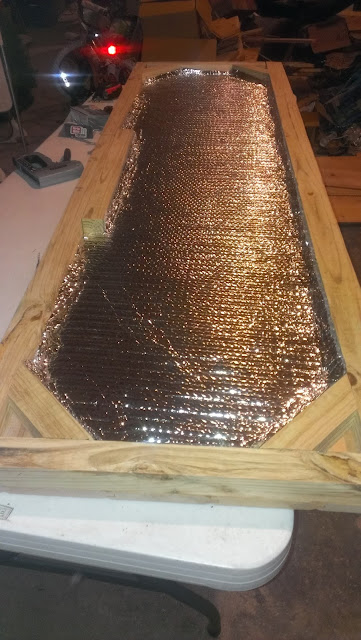 |
| Door insulation to keep the sauna hot! |
 |
| Door handle nailing plate. |
I also installed a nailing surface next to the frame for the
handle that will be added later and marked with a pencil the length of that
nailing surface on the outside of the frame. I then went on to cover the other
side of the door with cedar T&G. The T&G was attached to the frame with
brads. The perimeter pieces were nailed through the cedar to the frame, The
inner pieces were only nailed through the top and bottom of the cedar in to the
frame.
With the door complete, we took it in to the sauna one more
time to check fit. It looked nice. For our hardware, we bought three 4.5 inch
hinges, two of which are spring loaded so that the door would close on its own.
Leaving about a .25 inch offset, we installed the hinges on to the door frame
pre-drilling and installing one screw at a time, so that the hinge didn’t move
out of alignment. Once the hinges where secured to the door, we hung the door
on to the door opening using at least one 2 inch screw through the hinge in to
the studs. Our sauna now had a door and could be used for its real purpose!
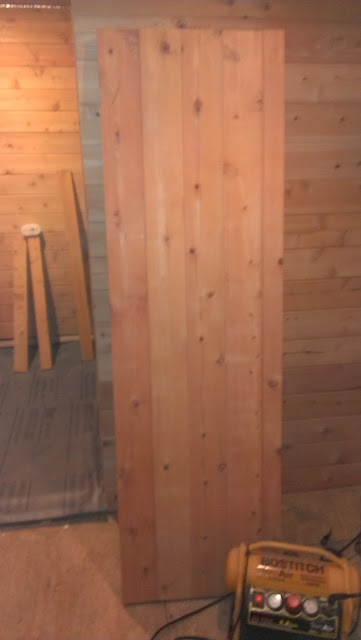 |
| Completed custom sauna door. |
 |
| Completed and hung custom sauna door. |
1/19/2017 UPDATE:
Having used the sauna at least 1-2 times per week throughout the year, I am happy to report that the door has not warped or changed shape in anyway. It is still as square as it was from day one.
Having used the sauna at least 1-2 times per week throughout the year, I am happy to report that the door has not warped or changed shape in anyway. It is still as square as it was from day one.
3/8/23 UPDATE:
Having received a few comments asking about the door hinges, I thought I post a photo of them.
 |
| Closeup of spring-loaded sauna door hinge. |
 |
| All 3 of spring-loaded sauna door hinges. |
Hooking up the wood burning stove to the chimney.
Once we were done with the cedar on the walls and ceiling,
we were ready to get the Kuuma sauna stove installed. First challenge was to
get it in the sauna building. The beast is made of quarter inch metal and weighs
350 pounds and takes in 100 pounds of FireBrick luckily in a separate box J . We wheeled the stove
out of the garage on a dolly, then had 3 guys pick it up and place it in to our
sauna building. Once inside, we set it on top of the patio pavers that it will
live on and adjusted its position to line up with the chimney in the ceiling.
From there, we needed to hook up the stove to the chimney support box with a single
wall black pipe. The pipe comes open and needs to be bent and clicked together
to assemble like a duct pipe. There are 2 sides to each pipe—a crimped side and
a straight side. The pipes are sold in 12 and 24 inch lengths I believe. There
may be others. Once I assembled the pipe in to a round stack, the crimped end
then went in to the stove. My stove had a hole in the receiving pipe for a
sheet metal screw to secure the pipe. I put in my pipe, marked the hole
location, took the pipe out, tapped and drilled the hole out.
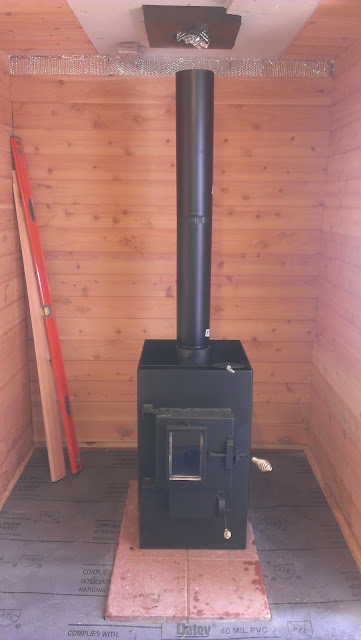 |
| Single wall black pipe hooked up to the stove. |
The stove also requires that a damper is installed in the
first pipe. This is a 6 inch pipe which requires a 6 inch damper. I dry fitted
the damper in to the pipe making sure that when it opens, the second pipe doesn’t
interfere with it. This means I set it about 5 inches from the top of the black
pipe. Once I found a good location, I taped and drilled the hole for the damper
shaft. Once I got the hole drilled, I installed the damper inside the pipe.
When it was in, centered and tested, I used the shaft to tap a mark on the
opposite side of the pipe where the shaft will exit. I took out the damper,
drilled the tapped hole. Now the damper could be installed fully. With the
damper installed, I put the pipe back in to the stove and secured it with a
sheet metal screw to the stove where I drilled the first hole. I then attached
the second pipe which got me closer to the support box. That second pipe is
attached to the first pipe via the crimped end and 3 sheet metal screws.
The support box came with a round smoke collar as part of
the kit. I slipped that collar in to the support box. It had 4 holes for
screws, but the fit for me was tight and I didn’t feel comfortable making holes
in the support box. For my last and final connection to the chimney support
box, I used what’s called a 6 Inch Adjustable Stove Pipe Slip Joint. It saves
you from cutting your stove pipe and is cheap! The deep part of it slipped over
the black pipe I had attached to the stove. The shallow part connects to the
chimney inside the chimney support box.
This slip joint is very tightly made to go over the pipe. A trick I used
is I sprayed WD-40 on a paper towel and applied it to the outside of the pipe
and inside the Slip Joint. I was then able to have it go on the pipe and move
freely enough to adjust it. After the first firing, it quickly burned off.
So, now that the Slip Joint was on the black pipe, I carefully
slid the Slip Join up and inserted it in to the chimney at the support box. I secured
it to the black pipe with 3 sheet metal screws.
With the stove finally hooked up to the chimney, all that was
left is to line the fire box with FireBrick according to the installation
instruction. Once done, we were ready for our first fire. Daryl, the builder of
the Kuuma stove, suggests burning about 3 small paper fires to cure the paint.
However, it took us about 3 good wood fires after 3 small paper fires before
the paint stopped burning off and the hot room was usable. Don’t rush it, take
your time and let it cure.
 |
| First firing of our Kuuma sauna wood burning stove. |
 |
| Wood burning Kuuma sauna stove with the lights turned off. |
Hanging Durock protection on ceiling over the wood burning stove.
A quick post about ceiling protection above the wood burning
Kuuma stove. According to the instructions for installation, I needed to have 2
half inch Durock layers of protection with a 2” air gap between them.
Originally, I was going to use 4 half inch pieces of scrap Durock for spacers
to give me the 2” air gap. In the end, what I decided to do is to place 2 2x4s
across the ceiling joists. That gave me a solid surface for attaching the last
layer of Durock, but they only made up for 1.5 inch air gap. I then added one
more half inch Durock spacer over the 2x4 followed by the full sheet of
protection Durock. Now that whole thing was solid and looked good with the
appropriate 2” air gap.
 |
| 2x4s to support final layer of Durock above the wood burning stove. |
Covering the walls and ceiling with cedar tongue and groove
Well, finally,
after a long process of building we were up to the big milestone step of
putting up the cedar. I guess the decision to start with walls or ceiling is up
to you, but I started with walls in the hot room. This work is pretty simple,
better done with 2 people, and shows significant results. You do need to decide
on which side of the cedar you want to use—rough or polished, and stick to it
as much as possible. After that, just remember to leave an 1/8” gap on both
sides of each cedar for expansion. Due to the wall framing, I put
the cedar horizontally so that it can be attached with brad nails to the studs.
Also, keep in mind, you probably bought the cedar T&G at the best price you
could find, so the boards won’t all be perfect. Remember to presort the boards
before cutting. Uglier go on the bottom and behind benches, nicest ones go to
right above the benches where people’s skin will touch. You’ll probably find
that some board are ugly on the side you’ve chosen to put up, but nice on the
other side. Don’t worry too much and use whichever side is nicest. Unless you
know which board you used the other side on, you won’t really notice it later. Also,
if you haven’t done so already, now is a good time to cut open any outlets or
speaker wires you may have previously covered up with the bubble foil. This is
your last chance before you accidently hide something.
To begin, I
started on the long wall of the hot room which was a little under 12 feet. I
cut the cedar board to size, set it over the drip edge with the groove side
down and put a long level on top of it. This is important as any small level
imperfection here will really show up 7 feet at the top. Once the first board
was level, I nailed it with the brad nails through the bottom of the tongue at
all the studs. When the next piece goes over the tongue, the brads get hidden.
 |
| Leveling the starting cedar tongue and grove board. |
 |
| Nail brads through the bottom of the tongue in to the wall studs. |
 |
| The brads get covered by the grove of the next cedar board. |
Once the first board is
leveled and attached, the rest just go on top one by one, groove over tongue.
One thing to remember here is to make sure the tongue is all the way in the
groove before nailing each subsequent board. Again, some boards you’ll find are
bowed—simply persuade them by pushing on them before putting a brad in. Do use
a level with each board to make sure you’re still level. Usually, if it shows
off level, means your tongue is not all the way in the groove, adjust and move
on.
Go up the wall until there’s
one more board left to put up, Leave it off for now. You’ll cut it to size and
put it up once the ceiling is complete. At this time, move on to the opposite
wall. The reason to do the opposite wall as opposed to the contiguous wall is
so that the wood join pattern looks uniform. The side walls will both have
cedar going over the cedar on the 2 opposite walls.
If everything is level, you’ll
be surprised to see that the cedar boards line up in the corners—meaning each
wall has the same row of cedar continuing—that looks nice! One issue you may
run in to is going over the top of the door, or the top/bottom of the window.
If you can have one continuous piece that just has the door/window cut in to it—it
looks best. If not, don’t worry, you can stop your cedar at the start and end
of the door, and put one separate piece above it.
A few months back, I bought
ceiling speakers on CraigsList—5 for $50. I planned to use 2 in the hot room. I
ran the wiring before I put up bubble foil and simply needed to cut the cedar
around each of the 2 speakers and put them in. Cutting around speakers and can
lights adds a little complexity, but with the right tool, it’s a non-issue.
Originally, I made my cuts with the Multi-purpose tool I bought when cutting an
opening for the chimney. However, later, a friend bought a jigsaw that made it
even easier!
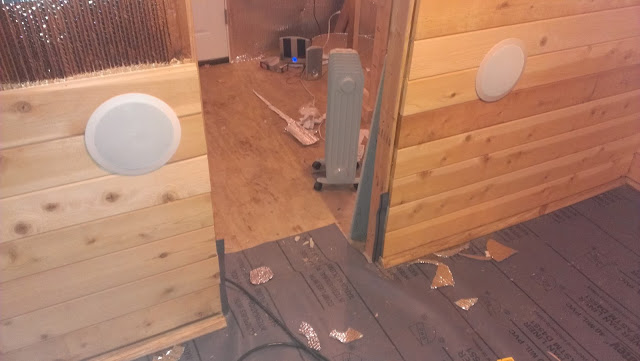 |
| Hot room speakers installed in to cedar. |
From here on, it’s just a
matter of time before the walls are done up to the last board where they meet
the ceiling. Before those go on, we start with the ceiling. The ceiling is done
the same way, minus the level checks (I didn’t do them). One thing you need to
make sure before you begin is that there are nailing surfaces everywhere to
hold your cedar in place. I found out I missed some above the stove where the
Durock was hung. At this stage, I ended up taking some of the bubble foil down
and added my nailing studs, then stapled the bubble foil back.
To start the cedar on the
ceiling, standing on a ladder, simply push the first board all the way to the
wall with the groove side and nail it with brads through the bottom of the tongue
to all studs. Go on putting the rest of the boards and cutting around lights
and the Durock above the stove. Again, make sure each tongue is all the way in
the grove the whole length of each board and nail.
Once the ceiling is complete,
using a table saw if needed, cut the wall cedar to the right width. Also,
because it’s the last piece at the wall & ceiling intersection, there’s not
much room for it to turn. The trick here is cut the one side of the groove off
on the back of the board. You can then push the board over the tongue rather
than putting the tongue inside the groove. Nail on all studs with brads.
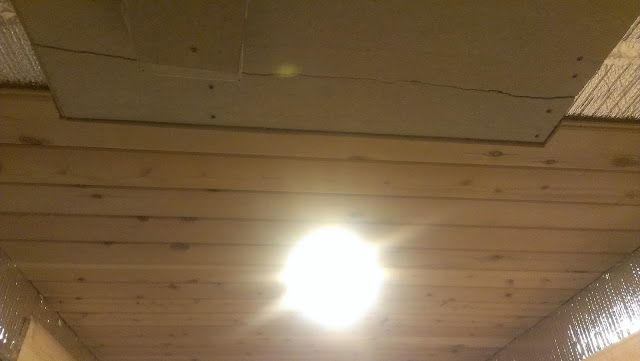 |
| Cedar on the ceiling. |
Now, with all the cedar up on
the walls and ceiling, you can be proud of the progress you made. The sauna is
getting close!
 |
| Wall cedar going up side wall. |
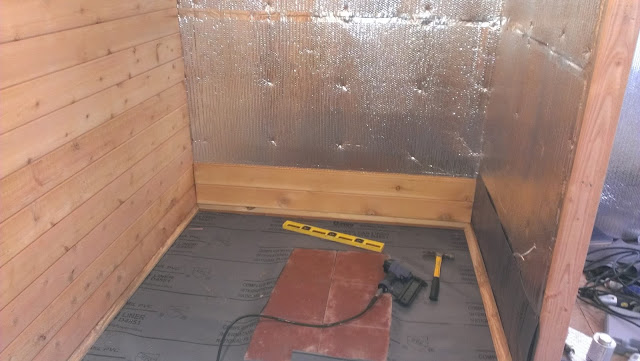 |
| More cedar tongue and groove. |
 |
| Corner of two cedar tongue & groove walls. |
 |
| Getting close to finishing the Tongue & Groove on the walls. |
 |
| Last tongue & groove cedar connecting wall to ceiling. |
 |
| Tongue & Groove cedar around the chimney Durock. |
Subscribe to:
Posts (Atom)


